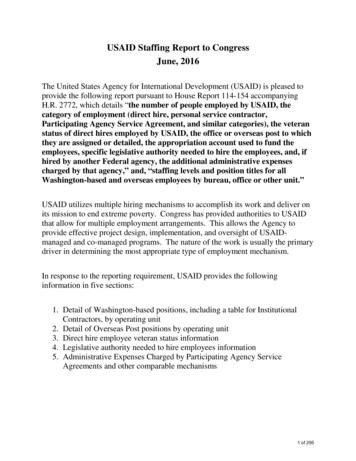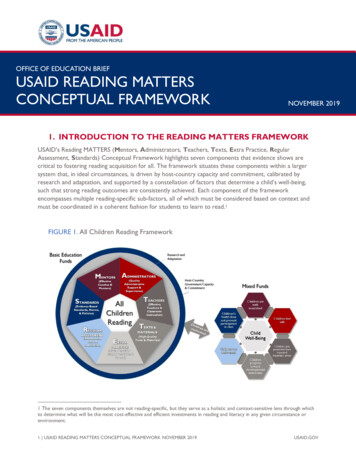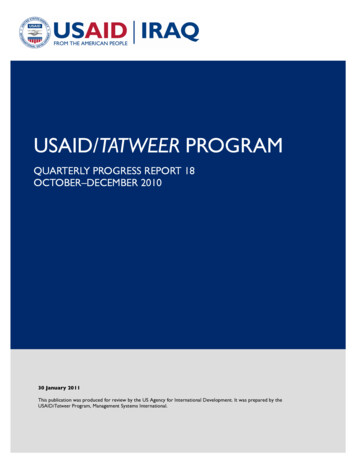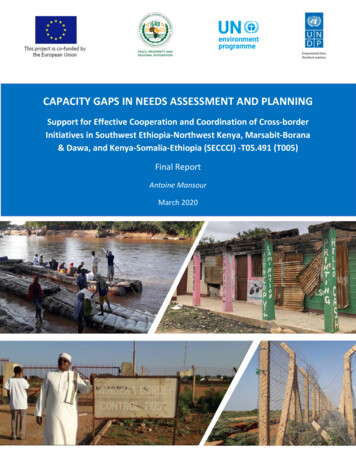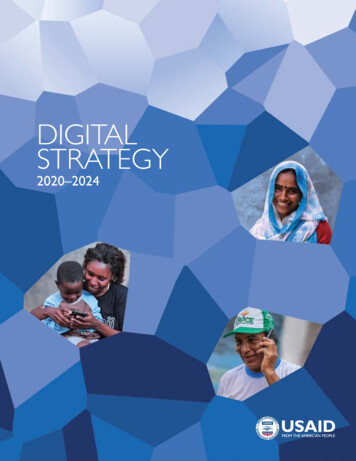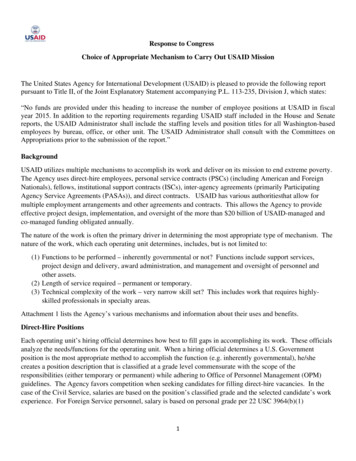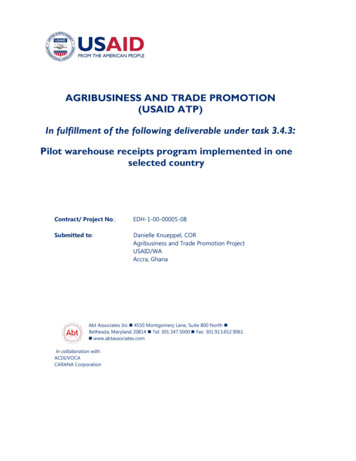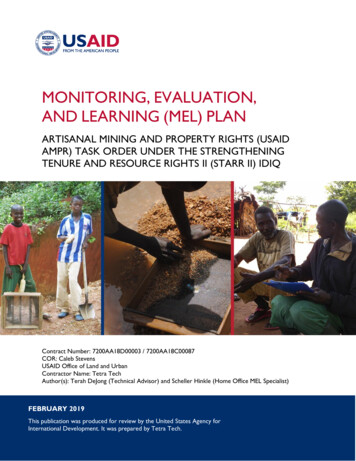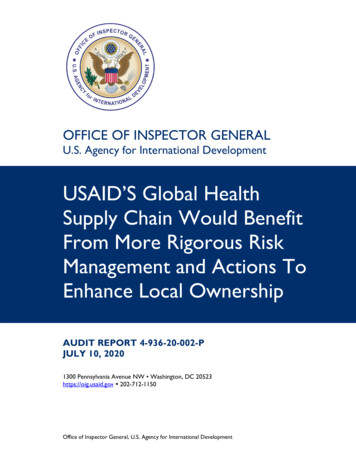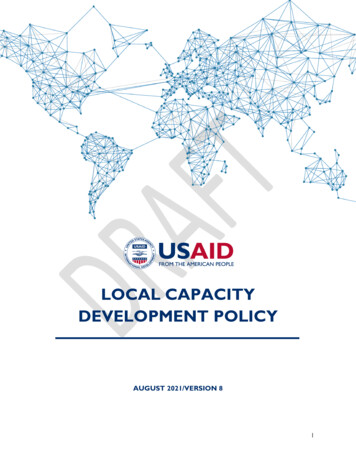
Transcription
LOCAL CAPACITYDEVELOPMENT POLICYAUGUST 2021/VERSION 81
LCD POLICY EXECUTIVE SUMMARYDeveloping local actors’ capacity is a foundational component of USAID programming that hascontributed to humanitarian and development gains around the world. Local capacity development is thecornerstone of sustainable development, which depends on local actors designing and leading efforts toimprove their communities. Developing local capacity is critical to addressing underlying factors offragility, strengthening local humanitarian response systems, and enhancing resilience to shocks andstresses. And it is vital to ensuring that marginalized and underrepresented groups have the skills andopportunities to lead on their country’s development.Over the past two decades, consensus has emerged across the development landscape around theimportance of local capacity development, yet Agency policy has not been updated to reflect thisconsensus. The Local Capacity Development Policy addresses this gap and affirms USAID globalleadership by providing a unifying and authoritative direction for the Agency based on mutual respect,reciprocity, and locally led capacity development.Seven Principles to Guide EffectiveLocal Capacity DevelopmentPRINCIPLE 1:Start with the local system.PRINCIPLE 2:Develop diverse capacities through diverseapproaches.PRINCIPLE 3:Align capacity development with localpriorities.PRINCIPLE 4:Appreciate and build on existing capacities.PRINCIPLE 5:Be mindful of and mitigate the unintendedconsequences of our capacity development.PRINCIPLE 6:Practice mutuality with local actors.PRINCIPLE 7:Measure performance improvement incollaboration with local actors.USAID’s Local Capacity Development Policyestablishes an Agency-wide vision and commonapproach towards developing local capacity thatcan be applied and adapted across the widevariety of sectors, contexts, countries, and sets ofactors with which the Agency works. This visionand approach are expressed through a frameworkand set of principles that will guide future USAIDhumanitarian assistance and developmentprogramming. By implementing this policy, USAIDis adopting a shared definition and understandingof local capacity development that will reorient itsprogrammatic approaches toward achievinglocally-led and -sustained development outcomes.Two mutually reinforcing pillars guide theAgency’s Local Capacity Development Policy: alocal capacity development framework and sevenlocal capacity development principles. Theframework pillar (provided in Section II) outlinesa process for making the decision to invest inlocal capacity development of specific actors inorder to contribute to sustainable systems-leveloutcomes. The framework comprises twointerdependent analytical processes: (1) a SystemsAnalysis, through which we make a determinationto invest in strengthening the capacities of selectactors as a means to improve system2
performance, and (2) Selection of Approach, where we identify the appropriate approach or set ofapproaches for strengthening the capacity of those actors.The second pillar consists of seven principles for effective local capacity development (Section III) thatshould guide how we support, engage with, and devolve power and leadership to local actorsthroughout the above-mentioned framework and across USAID’s Program Cycle. These principles,along with the framework, will guide USAID in making strategic and intentional decisions related tostrengthening the capacity of local actors in a manner that is inclusive, equitable, and rooted in localleadership and ownership.Section IV of the Policy describes a change management process for putting the framework andprinciples into practice that includes the following action areas:1) Integrate effective local capacity development into the Agency’s Program Cycle.2) Align Agency policy and resources with effective local capacity development practice.3) Develop and disseminate technical guidance on local capacity development to the field.4) Continue to advance procurement reform.5) Incentivize and support uptake of the Policy among the Agency’s Missions and Operating Units.6) Spearhead innovation, learning, and accountability across USAID.This process is intended to operationalize the Agency’s vision for local capacity development, wherebyUSAID contributes to achieving and sustaining development outcomes and effective local humanitarianresponse systems by making strategic and intentional decisions about why and how to invest in thecapacity of local actors, based on a shared understanding of the principles for effective local capacitydevelopment.3
A SHARED VISION FOR LOCAL CAPACITY DEVELOPMENTCapacity development of local actors is and has been afoundational component of USAID programming that hascontributed to humanitarian and development gains around theworld. Strong local capacity is a cornerstone of sustainabledevelopment, which depends on local actors designing andleading efforts to improve their communities and workinginclusively and collectively to see those efforts through.Effective local capacity development can also addressunderlying factors of fragility, strengthen local humanitarianresponse systems, and enhance resilience to shocks andstresses, ultimately supporting countries to prevent, mitigate,and recover from crises. Moreover intentional and strategiccapacity development can help ensure that individuals frommarginalized and underrepresented groups, including LGBTQI people, women and girls, persons with disabilities, indigenouspeoples, marginalized ethnic and religious populations,internally displaced persons, youth and elderly, and othersocially marginalized individuals, have the skills andopportunities to meaningfully lead in the development of theircommunities and country. In short, the capacity of local actorsis a key determinant of success in both the development andhumanitarian assistance spaces.Over the past two decades, consensus has emerged across thedevelopment landscape around the importance of localcapacity development in contributing to sustainable change.High level commitments of international developmentorganizations, donors, and developing country governments,including those made at aid effectiveness global summits inParis, Accra, and Busan, and reinforced through internationalagreements such as the Sustainable Development Goals(SDGs), have stressed the centrality of national capacity andlocal ownership to achieving sustainable outcomes.Capacity, as understood and used byUSAID, is the ability of an actor toperform, sustain itself, and self-renew.Capacity encompasses the knowledge,skills, and motivations, as well as therelationships, that enable an actor—anindividual, an organization, or anetwork—to take action to design andimplement solutions to localdevelopment challenges, to learn andadapt from that action, and to innovateand transform over time. Capacity ofany one actor is highly dependent upontheir fit within the context of a localsystem and the enabling environment.Local capacity development is aninvestment in local actors—individuals,organizations, and networks—to jointlyimprove the performance of a system inproducing valued developmentoutcomes. Effective local capacitydevelopment strategically andintentionally supports an actor’s abilityto achieve their own mission, to takeaction to design and implementsolutions to local developmentchallenges, to learn and adapt fromthat action, and innovate and transformover time. In doing so, it strengthenslocal actors’ contributions to theperformance of their local system.Local actors have also affirmed the importance of capacity development that is strategic, inclusive, andlocally led. Consultations with local actors to inform this policy reflect an agreement that capacitydevelopment programming enables local individuals, organizations, and networks to better serve theircommunities, respond more effectively in crisis situations, develop specialized sectoral expertise,mobilize resources, influence policy, and eventually move beyond the need for donor funding. However,local actors have also long expressed concerns about how donors and international organizationsunderstand and support capacity development: they repeatedly highlight the tremendous local capacitythat already exists and often goes untapped by international actors.4
Despite this emerging consensus and the central nature of local capacity development programming toUSAID’s work, no unifying and authoritative Agency policy on capacity development has existed untilnow.At the same time, approaches to capacity development have evolved. Whereas earlier approachesprimarily emphasized linear planning, relied on standardized capacity assessment tools implemented byothers, and supported the development of a narrow range of capacities through training, emergingapproaches emphasize systems thinking, the use of participatory approaches for understanding theaspirations, goals, and needs of local actors within their context, and strengthening collective capacityacross an array of local actors to influence change. This shift has occurred because research and practicehave documented that earlier blueprint-based approaches, despite their ubiquity, have fallen short inimproving individual or organizational performance that leads to sustainable change at the systems level.Local capacity development cuts across every sector, country, and context where USAID works. Itlooks different and takes on different forms depending on the sector and the actor, including: Working with local citizens and government officials in Indonesia to improve strategic planningfor humanitarian and emergency response,Supporting local cacao cooperative businesses in Peru to improve the quality of harvests andoverall productivity in order to tap into export markets,Providing professional development assistance to women teachers and administrators in Liberiain order to improve recruitment and retention of women educators,Engaging with marginalized populations in Nigeria to strengthen coalitions of diverse actorsaround common areas of interest in order to scale up collective action efforts to advocate forgovernance reforms,Supporting local faith leaders in Zambia to communicate effectively and provide resources totheir communities on malaria services,Strengthening Philippine Universities’ science and technology research capacity,Supporting press freedom and the public’s access to balanced reporting in the Balkans byproviding media outlets in the region with mentoring and coaching support aimed at improvingquality of content, news formats, financial viability, and audience engagement,Working with Ministries of Agriculture across Africa to improve the use of data and toundertake more transparent, inclusive, predictable, and evidence-based policy making,Scaling climate action by providing mentorship, incubation, and acceleration services tostrengthen business plans, operations and management, and access to finance for Indian smallbusinesses that provide off-grid, clean energy solutions, andTraining young female tractor drivers in Uganda in areas where there is a driver deficit, andcollaborating with farmers to shift perceptions and increase market demand.And many other examples that illustrate the various ways USAID works with diverse actors tostrengthen local actors’ capacity to deliver results over time.(Note: As highlighted in Section II, local capacity development should strengthen the roles, functions,and interactions of multiple actors within a local system, and should be enhanced by complementaryapproaches that strengthen the overall system.)5
USAID’S VISION FOR LOCAL CAPACITY DEVELOPMENTUSAID contributes to achieving and sustaining development outcomesand effective local humanitarian response systems by making strategicand intentional decisions about why and how to invest in the capacity oflocal actors, based on a shared understanding of the principles foreffective local capacity development.6
USAID has a unique opportunity to set a new vision and agenda for effective local capacity developmentthat builds on years of programmatic experience, evidence, feedback from local actors and partners, andthe consensus that now exists across the development landscape. This new vision and agenda will begrounded in a commitment to partnerships based on mutual respect and reciprocity, through whichlocal actors from all backgrounds and cultures have their voices heard, exercise their unique capabilities,and lead their country’s development. In so doing, USAID can ensure that the principles of diversity,equity, and inclusion are present in all of our capacity development programming.The purpose of this policy is to establish an Agency-wide shared vision and common approach to localcapacity development. This vision and approach is based on a shared set of principles that will guide allrelevant USAID humanitarian assistance and development programming. Through implementation of thispolicy, and within the context of U.S. Government strategic priorities, USAID will: articulate a commondefinition and shared understanding of local capacity development; orient programmatic approachestoward achieving locally owned and sustained development outcomes; and establish agreement aroundthe core principles of effective local capacity development.This policy is formulated around two mutually reinforcing pillars: a framework (described in Section II) for understanding how a local capacity developmentapproach—when combined with complementary interventions under a strategic program designprocess—can contribute to broader systems change and sustainable outcomes, and seven principles for effective local capacity development (presented in Section III) that will guideour programming across sectors, contexts, and regions.The framework and the seven principles complement one another by providing the logical reasoning forhow to strategically, intentionally, and effectively make decisions to invest in local capacity developmentprogramming.The practices and principles outlined in Sections II and III are supported by a robust evidence base(Annex I) and a rigorous consultation process through which USAID prioritized the engagement andfeedback of local actors and organizations to develop, inform, refine, and validate the principles andpractices of the policy (see Annex 2 for more background on this consultation process). Section IV ofthis policy describes how we plan to put this framework and the seven principles into practice byoutlining a change management process, key requirements, and a governance structure for ensuringeffective implementation of the policy.7
LOCAL CAPACITY DEVELOPMENT AS A PROGRAMMATIC APPROACHCapacity development of local actors is one of the most effective ways to advance sustainabledevelopment. However, investments in local capacity do not automatically lead to improved andsustained development and humanitarian results. Nor is capacity development always the necessaryprogrammatic approach: USAID should not approach every challenge or context with the assumptionthat local actors lack capacity. Effective capacity development programming requires intentionality,resources, and longer time horizons. Sustained progress is more likely to be attained when capacitydevelopment is understood as a strategic and intentionalprogrammatic approach guided by the core principlesoutlined in this policy.Local System refers to theinterconnected set of actors thatThe foundation for a rigorous approach to capacityjointly produce a particulardevelopment is built on an appreciation of the connectiondevelopment outcome. These actorsbetween capacity and sustainable change at the systemsmay include individuals,level: strong capacity of local actors that is demonstratedorganizations, and networksthrough effective performance can contribute torepresenting government, civil society,sustainable system-level change. All development resultsthe private sector, and universitiesemerge from the interaction of many actors, includingand research institutes - as well asindividuals, organizations and networks representingUSAID and implementing partners.government, civil society, the private sector, universitiesAs a set of interconnected actorsand research institutes, and other entities. Strengthening ajointly producing an outcome, theylocal system and ensuring development gains areare “local” to it. Local systems maysustained by local actors over time usually entails somereflect or cut across sub-national,form of capacity development of local actors, whetherfocused on enhancing their knowledge or skills,national, or regional geographies.strengthening relationships among them, or catalyzingcollective action among them.Performance refers to the extentto which an actor is able toThis foundational understanding of capacity developmenteffectively and consistently achieve itsinforms two key decision-making processes: (1) theintended outcomes. Performance isdecision to invest in strengthening the capacities of selectthe key consideration in determiningactors as a means to improve system performancewhether capacity has been changed(Systems Analysis), and (2) the process through whichwe identify the appropriate approach or set ofapproaches for strengthening the capacity of those actors(Selection of Approach). 1Systems analysis. Local systems analysis informs thedecision to invest in a capacity development approach byhelping us understand how strengthening the capacity ofkey actors might contribute to sustainable social change atPerformance Improvement is aprogrammatic approach that refersto a deliberate process undertaken toimprove an actor’s realization oftheir goals.1Note: Systems analysis and selection of approach often happen simultaneously, and not sequentially, as part of the designprocess.8
the system level. Three important considerations guide this decision-making process: First, we must appreciate that systems are composed of different types of actors and that resultsemerge from the actions and interactions of these actors. In some systems, the government is adominant actor. In others, private sector actors, NGOs, or traditional and religious leaders arepredominant actors. In most cases, many types of actors contribute to system performance.Regardless, we must embrace an inclusive approach to systems analysis and understand therange of actors—including marginalized and underrepresented groups—in the system, theunique roles they play, and then determine if strengthening the capacity of select actors toperform roles that may influence system-level outcomes is necessary. An inclusive approach tosystems analysis includes the recognition that all individuals are instrumental in thetransformation of their societies and have important resources, ideas, and energy that areessential to sustaining development. Second, because results and ownership of solutions emerge from the interactions of manyactors, expanding our focus beyond a single actor’s capacity is more likely to make a significantdifference to overall system performance. So, we must consider opportunities to engagemultiple actors in the system -- especially by supporting them to realize collective impact. Third, strengthening the performance of the whole system often requires going beyond justcapacity development and addressing other constraints through complementary interventions.We may need to help address harmful power dynamics or other incentives that limit actors'ability to change, or identify ways to unlock financial resources needed for the system tofunction better. Thoughtful systems approaches to design can help practitioners understand howaddressing these constraints and barriers in the system can enable local actors to fully expresstheir capacity and self-realize change.After thoroughly considering these systems analysis considerations in collaboration with localstakeholders, we should ask: Can strengthening the capacity of key actors contribute to sustainable9
change at the systems level? If the answer is ‘no,’ then we should explore other programmingapproaches that may be more relevant for achieving sustainable development outcomes. If the answer is‘yes,’ then we can confidently move forward to make strategic and intentional decisions about how toinvest in a capacity development approach.Selection of Approach. Once USAID has made the decision -- in collaboration with localstakeholders—to invest in the capacity development of specific local actors, we can determine the mostappropriate approach for doing so. There are a wide range of approaches for strengthening capacity—coaching, facilitation, network-building, training, co-creation, local awards, technical assistance, catalyzingcollective action, and many others. The decision about which approach to pursue, should be informed bythe following considerations: First, we must work with local actors to understand their capacity development needs,objectives, and opportunities. To the extent possible, we should build our approach around thepriorities, existing strengths, and goals of local actors, paying special attention to ensure that thevoices and priorities of marginalized and underrepresented groups inform this process. We alsomust appreciate that each actor is different, develops in uniqueways, and has distinct priorities, so we must be prepared totailor and avoid a one-size-fits-all approach.Locally led Second, USAID must understand its own unique role withinthe system. Our comparative advantage as a donor will differbased on the existing capacities, resources, and connections oflocal actors, of other international organizations, and ofdonors within the local system. It might be our ability toconnect local actors with desired sources of technicalassistance, to convene local actors with global actors, tostrengthen relationships and connections across the system, orto direct resources to key local actors to strengthen theirinfluence. Having a full understanding of the unique role weplay in a local system will also inform the approach we take. Finally, we must consider the role that our financial resources play in advancing local capacitydevelopment. Our resources can be a powerful way to support—both directly and indirectly—the capacity development of local actors. Funding local actors through direct awards can be aneffective way to strengthen the ability of local actors to “learn by doing” and to enhance localleadership and influence, which are respectively an important approach and form of capacity.Additionally, resources that are provided indirectly through implementing partners can helplocal actors access specialized expertise and forge new network connections.development is theprocess in which localactors set their ownagendas, developsolutions, and bring thecapacity, leadership, andresources to make thosesolutions a reality.In sum, a strategic and intentional design process that takes into account these considerations forsystems analysis and for a selection of approach will help us: identify engagement and partnershipopportunities with the appropriate local actors in a system; better understand how a capacitydevelopment approach—complemented with other context-relevant interventions—contributes tosystems change; and understand the unique needs of our partners and leverage our comparativeadvantage to increase the capacity of local actors and systems. The outcome of this analytical and designprocess should serve as the foundation of our theory of change for local capacity development.10
A NOTE ON LOCAL AWARDS AND RISKAs outlined in Section II, the decision to use a local award to strengthen capacity derives from arigorous design process. It begins with a systems analysis through which USAID -- in partnership withlocal stakeholders -- identifies a specific actor or set of actors whose improved performance is likely tocontribute to sustained systems change. The process then proceeds to identify which additionalcapacities are needed to improve performance -- again in partnership with the actors themselves -- and,in many cases, concludes with the determination that a local award is indeed the most effective optionfor supporting that actor’s capacity development. In following through this process, an award becomesmore than a financial transaction. It has become an integral and essential part of the programmaticdesign and therefore an integral and essential contributor to achieving and sustaining developmentresults.In keeping with this programmatic approach, financial and management risk associated with a local awardmust be evaluated in the context of the overall programmatic logic. This means that USAID needs totake a holistic approach to risk that weighs fiduciary and management risk alongside programmatic,reputational, and other considerations of risk. For example, in some cases, it may be appropriate toaccept a higher level of fiduciary risk in light of the programmatic necessity of a local award. Consideringthese different types of risk in tandem enables us to holistically assess whether the award is a wiseinvestment. It also helps us to support development of local actors’ skills in managing funds withoutlosing focus on the capacities needed to perform effectively, deliver results, and achieve and sustainsystems level outcomes.Further, reductions in fiduciary risk to USAID and improvements in local capacity are usually not thesame thing. Because our fiduciary risk is linked to our award requirements, it often shifts the focus ofour partnership towards risk avoidance, compliance, and short-term, easily-counted results, instead offocusing on improving the performance of the partner to pursue their own mission. Therefore, it is notappropriate to substitute a risk assessment for a capacity assessment, nor to substitute a riskmanagement plan for a capacity development plan. Risk and capacity development plans should becarried out separately and in tandem to provide the best benefit for local actors.Such a holistic assessment of the opportunities and risks associated with a capacity developmentapproach is entirely consistent with USAID’s guidance on enterprise risk management (ERM).2Furthermore, leaning into the positive programmatic outcomes associated with working through localpartners -- even if they are not certain -- is consistent with the Agency’s Risk Appetite Statement. Thisapproach still requires thoughtful risk mitigation, monitoring, and, as appropriate, acceptance, but of theoverall capacity development approach and not its discrete elements, including any local awards.2Playbook: Enterprise Risk Management for the U.S. Federal Government. L-ERM-Playbook.pdf11
LOCAL CAPACITY DEVELOPMENT PRINCIPLESEffective and sustainable local capacity development requires a “best fit” approach—not a “bestpractice” approach. USAID support for local capacity development must be tailored in a way that alignswith sector needs, country and regional contexts, and USAID and partner country priorities. Yet,USAID also must make strategic and intentional decisions about why and how to invest in the capacityof local actors. Therefore, to ensure a coherent approach to local capacity development across diverseprogramming portfolios that supports local actors to own and manage their own progress, USAID hascommitted to adopting a set of shared principles.Principles are neither values nor rules. Unlike values, principles are action-oriented and guide us tochoose among different programming options. Unlike rules, principles are flexible and enable coherencewithout being prescriptive. It is within the confines of this intention—to guide with flexibility—thatthese seven principles for effective local capacity development are presented.PRINCIPLE 1: START WITH THE LOCAL SYSTEMPRINCIPLE 1 AT-A-GLANCE Listen to the system to inform the decision to develop localcapacity.Tailor capacity development to match partners’ fit into thesystem.Local actors—individuals, organizations, and networks—should play the most important roles assystems changemakers within their communities. Therefore USAID investments in capacity developmentmust focus on supporting local actors to perform roles that enable them to catalyze and achieve positivesocial change in local systems. In practice, this starts with understanding the local system and the fit oflocal actors within it.Listen to the system to inform the decision to develop local capacity. Capacity development ismeaningful only in the context of how a local system operates and how actors embedded within thatsystem carry out their roles and interact with one another, the rules of the system, and the resourcesto be found there. Before intervening, it is important to listen to the system to learn how it currentlyfunctions (by understanding its context and existing capacities) and understand its dynamic complexity(reflected in relationships among system actors and through feedback loops). Listening is more thanpassively taking in information. So that we may adequately understand how the system functions, theroles and relationships of the actors in it, and the range of local perspectives and voices, listening meansthat we must jointly make sense of what we are perceiving with local actors, including those frommarginalized and underrepresented groups, including LGBTQI people, women and girls, people withdisabilities, indigenous peoples, marginalized ethnic and religious populations, internally displacedpersons, youth and elderly, and other socially marginalized individuals. Our decision to invest in capacitydevelopment programming, as well as our expectation about the types of performance improvement12
that our programming is likely to catalyze and support, should be guided by people in and affected bythe local system.Tailor capacity development to match local actor needs and fit to the lo
network—to take action to design and implement solutions to local development challenges, to learn and adapt from that action, and to innovate and transform over time. Capacity of any one actor is highly dependent upon their fit within the context of a local system and the enabling environment. Local capacity development. is an investment in local actors—individuals, organizations, and .
